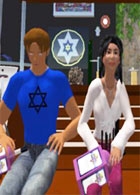Imagined Communities

"The plain sense of things," Wallace Stevens wrote, "had itself to be imagined." Without imagination, there is no culture, language, or for that matter any recognizably human life. But what happens to the "plain sense of things" in the computer age when, with the emergence of virtual reality and virtual community, imagined life can take over, subsume, or become a substitute for recognizably human life?
The question presses itself with special urgency in the case of Judaism and the Jews. A specific people, a specific place, a framework of mitzvot laying emphasis on what we eat, utter, and do: all of these are aspects of a central feature of Judaism, namely, its embodiment. All seem to live in exquisite tension with the virtual dispensation of cyberspace.
The issues are perhaps no more clearly on display than in Second Life, the virtual world created by Linden Labs. The Jewish members, or "Javatars," of Second Life attend synagogue, light Hanukkah candles, and study Jewish texts. At various times the world of Second Life has hosted replicas of the Western Wall, the biblical Tabernacle, a Jewish city, and, needless to say, a Chabad House.
For many this invigorates learning, fosters a sense of community across distances, and enables a creative exploration of Jewish selfhood and group identity. No doubt. But what, in the electronic ether, is to become of flesh-and-blood Jewish life? The Talmud says (Sotah 14a) that God Himself clothes the naked, feeds the hungry, buries the dead. In virtual worlds one cannot do any of those things; nor can one visit the sick, shake a lulav, or recite kiddush and then drink the wine.
For that matter, what is to become of religious imagination? The imaginative exertions of prophets, philosophers, and mystics gained much of their charge, including their visual charge, from the ultimate inability truly to picture that which was being envisioned. Will that mystery vanish, too, in an age when technology can render the most ineffable vision with stark pictorial quality?
Throughout Jewish history, new communication technologies have been seized upon as keys to both study and belonging. That today's new technologies have been a godsend to the dispersed Jewish people is undeniable; equally undeniable, though, is that they present a conundrum. Like any technology, virtual reality is a tool, one that can enrich or diminish human existence depending on how it is used. Like any technology, it is also a culture, one whose moral and spiritual value will be created or wasted by the people who inhabit it.
Comments are closed for this article.




